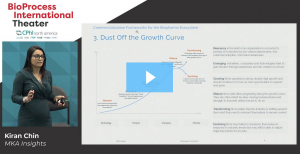- Sponsored Content
Commercialization Frameworks for the Biopharma EcosystemCommercialization Frameworks for the Biopharma Ecosystem
July 16, 2019
Sponsored by MKA Insights
 Kiran Chin, managing partner and CEO, MKA Insights
Kiran Chin, managing partner and CEO, MKA Insights
Chin began her presentation by introducing her company and its focus on helping bioprocess, life sciences, clinical diagnostics, and gene therapy companies accelerate growth. Although there is no shortage of information on data processes, Chin has found that many companies lack focus on some fundamentals that drive commercialization strategies. Companies tend to dive in without asking basic questions: Why do we exist? What are our capabilities? What is the technology that we feel is our competitive advantage? What is the unmet need? What are the customer challenges we’re trying to solve? What do people want to purchase? Are there smaller niches we can target rather than one large audience?
Chin firmly believes that history is predictive of the future. She said that people have the ability to change the future only if they can see what they’ve done in the past. They do so by analyzing financials, performance, where they have made missteps, and how to modify their approaches based on what’s happening in the industry. They should ask what resources they have that will allow them us to achieve their goals. Evaluating competition is also key.
Chin then highlighted several data curves that she feels are not followed often enough. The adoption curve, for example, is a critical model that should be used. Many companies have moved away from this curve and thus lost fundamental understanding of why customers buy, what they buy, and when.
One key topic Chin brings forward is that companies need to determine where they sit in the adoption cycle. In this industry, innovators and early technology adopters can struggle to encourage the majority of buyers to adopt their products and services. Such basic buying patterns should not be overlooked in examinations of commercialization
strategies.
Chin then touched upon the growth curve, which dictates strategy and commercialization planning. She said that “if you’re nascent, you have an idea that’s worth pursuing. As you get more buy in and move into the emerging sector and market as an emerging technology, the messaging and strategy shift, and you tend to receive increased funding. You also may want to explore distribution partnerships or go to a market that broadens reach. Once you shift from nascent to emerging, momentum is gained. This is where people get excited because they see single-digit, then double-digit growth.”
Across the industry and its products, and throughout company growth cycles, Chin has found that companies inevitably approach a maturity level at which growth starts to taper off. Chin says this can be a telling time for companies: “What do you do? You have a decision to make. Do you continue to ride single-digit growth, do you try to
transform yourself, or do you decline? The biopharmaceutical industry as a whole has faced this. Companies face the patent cliff, for example. They chose either to dig in with their heels and challenge the patent expiry — or conversely, some biopharmaceutical companies ride the wave and enter the biosimilars space.”
Understanding the implications of the growth curve is important to understanding your commercialization strategy. Describing the industry, Chin said that she likes to think of
the biopharmaceutical ecosystem as a four-dimensional dynamically moving “ecosystem” that’s propelled forward by time. “It started with fantastic ideas in Boston about what a biologic could be. That was the core of the biologics industry.
It has grown outward over time with more ideas coming into the fold,” she said.
Companies have reached outward, but some ideas fail to thrive or are slow to move outward, and other ideas never move forward. The biopharmaceutical ecosystem is
transforming as the industry moves into newer spaces through innovation. Companies are moving into cell and gene therapies, advanced therapies, and mRNA therapies. “The industry is changing its dynamic constantly. If you are on the outskirts, you have a different kind of opportunity to push the boundaries and push the industry as whole into
new directions, but if you’re in the inside and closer to that nebula that kicks off ideas, you have a long view. You can see those opportunities more clearly than the big guys on the exterior, and you can navigate a lot faster to the end goal in a shorter period,” she concluded.
You May Also Like






